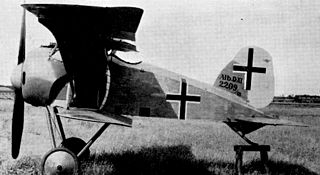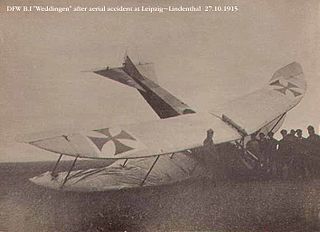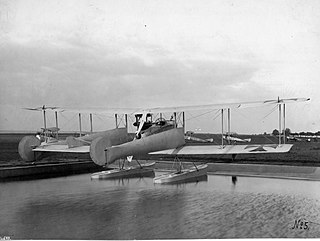Related Research Articles

The Fokker Dr.I, often known simply as the Fokker Triplane, was a World War I fighter aircraft built by Fokker-Flugzeugwerke. The Dr.I saw widespread service in the spring of 1918. It became famous as the aircraft in which Manfred von Richthofen gained his last 17 victories, and in which he was killed on 21 April 1918.

The Gotha G.I was a bomber aircraft used by the Luftstreitkräfte during the First World War.

The Idflieg designation system was used to classify German heavier-than-air military aircraft from the early days of the Fliegertruppe/Luftstreitkräfte to the end of World War I. The system evolved during this period as new classes of aircraft came into use.

The Albatros B.II, was an unarmed German two-seat reconnaissance biplane of the First World War.

The Deutsche Luftstreitkräfte —known before October 1916 as Die Fliegertruppen des deutschen Kaiserreiches —was the air arm of the Imperial German Army. In English-language sources it is usually referred to as the Imperial German Air Service, although that is not a literal translation of either name. German naval aviators of the Marine-Fliegerabteilung were an integral part of the Imperial German Navy. Both military branches operated aeroplanes, observation balloons and airships.
Luft-Fahrzeug-Gesellschaft, also referred to as LFG, was a German aircraft manufacturer during World War I. They are best known for their various "Roland" designs, notably the Roland C.II Walfisch (whale), Roland D.II haifisch (Shark) and Roland D.VI, although they also produced a number of airships and many experimental designs.

The Caudron G.3 was a single-engined French sesquiplane built by Caudron, widely used in World War I as a reconnaissance aircraft and trainer.
Luftverkehrsgesellschaft m.b.H. was a German aircraft manufacturer based in Berlin-Johannisthal, which began constructing aircraft in 1912, building Farman-type aircraft. The company constructed many reconnaissance and light bomber biplanes during World War I.

The Aviatik B.I is a German two-seat reconnaissance biplane designed and built by the Automobil und Aviatik AG company, who until then had produced copies of French designs.

The DFW B.I, was one of the earliest German aircraft to see service during World War I, and one of the numerous "B-class" unarmed, two-seat observation biplanes of the German military in 1914, but with a distinctive appearance that differentiated it from contemporaries. Though a biplane, its crescent-planform three-bay wings were inspired by that of the earlier Rumpler Taube monoplane, and led to the DFW aircraft being named the Fliegende Banane by its pilots.

The DFW C.IV, DFW C.V, DFW C.VI, and DFW F37 were a family of German reconnaissance aircraft first used in 1916 in World War I. They were conventionally configured biplanes with unequal-span unstaggered wings and seating for the pilot and observer in tandem, open cockpits. Like the DFW C.II before them, these aircraft seated the gunner to the rear and armed him with a machine gun on a ring mount. Compared to preceding B- and C-class designs by DFW, however, the aerodynamics of the fuselage were more refined, and when coupled with more powerful engines, resulted in a machine with excellent performance.

The Gotha LD.1 and its derivatives were a family of military aircraft produced in Germany just before and during the early part of World War I. Used for training and reconnaissance, they were conventional designs with two-bay unstaggered wings, tailskid landing gear, and two open cockpits in tandem. Made quickly obsolete by the rapid advances in aviation technology, several were supplied as military aid to the Ottoman Empire when withdrawn from German service.

The Gotha WD.3 was a pusher reconnaissance floatplane built in prototype form in Germany in 1915.

The Gotha WD.7 was a reconnaissance floatplane developed in the German Empire during World War I.

The LVG B.I was a 1910s German two-seat reconnaissance biplane designed by Luft-Verkehrs-Gesellschaft for the Luftstreitkräfte.
Halberstädter Flugzeugwerke or Halberstadt was a German aircraft manufacturer. It was formed on 9 April 1912 under the name Deutsche Bristol Werke Flugzeug-Gesellschaft mbH in Halberstadt, Province of Saxony.
The Sablatnig SF-5 was a reconnaissance seaplane produced in Germany during the First World War.
The Halberstadt B-types of the Halberstädter Flugzeugwerke were two-seat unarmed reconnaissance/training aircraft of the German Air Force in the First World War.

The Gotha LD 5 was a military aircraft produced in Germany during the early part of World War I.
References
Bibliography
- Herris, Jack (2013). Gotha Aircraft of WWI: A Centennial Perspective on Great War Airplanes. Great War Aviation Centennial Series. Vol. 6. Charleston, South Carolina: Aeronaut Books. ISBN 978-1-935881-14-8.
- Günter Kroschel, Helmut Stützer: Die deutschen Militärflugzeuge 1910 – 1918. Lohse-Eissing, Wilhelmshaven 1977. ISBN 3-920602-18-8
- Metzmacher, Andreas (2021). Gotha Aircraft 1913-1954: From the London Bomber to the Flying Wing Jet Fighter. Brimscombe, Stroud: Fonthill. ISBN 978-1-78155-706-8.
- Heinz Nowarra: Die Entwicklung der Flugzeuge 1914 – 1918. Lehmanns, München 1959.